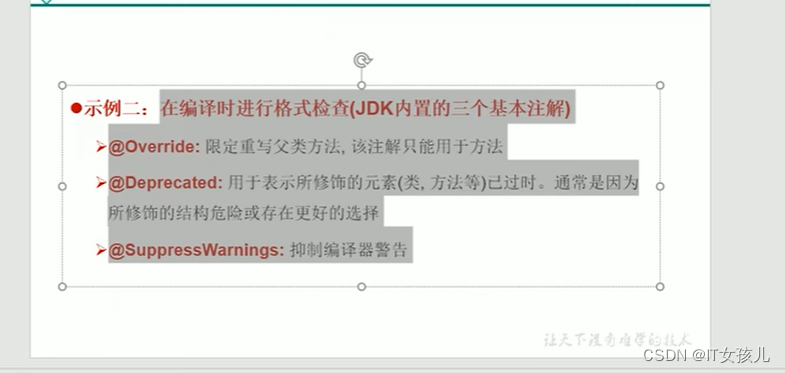提示:文章写完后,目录可以自动生成,如何生成可参考右边的帮助文档
文章目录
提示:以下是本篇文章正文内容,下面案例可供参考
一、在编译时进行格式检查(JDK内置的三个基本注解)

二、使用步骤
1.理解Annotation
① jdk 5.0 新增的功能
② Annotation,其实就是代码里的特殊标记,这些标记可以在编译,类加载,运行时被读取,并执行相关操作,程序员可以在不改变原有逻辑的情况下,在源文件中嵌入一些补充信息。
2.Annocation的使用示例
示例一: 生成文档相关的注解
示例二: 在编译时进行格式检查(JDK内置的三个基本注解)
@Override: 限定重写父类方法,该注解只能用于方法@Deprecated: 用于表示所修饰的元素(类,方法等)已过时。@SuppressWarnings: 抑制编译器警告
示例三: 跟踪代码依赖性,实现替代配置文件功能
3.如何自定义注解
参照@SuppressWarning定义
① 注解声明为: @interface
②内部定义成员,通常使用value表示
③可以指定成员的默认值,使用default 定义
④如果自定义注解没有成员,表明是一个标识作用
如果注解有成员,在使用注解时,需要指明成员的值。
自定义注解必须配上注解的信息处理流程( 使用反射)才有意义。
自定义注解通过都会指明两个元注解: Retention、Target
4.jdk 提供的4种元注解
元注解:对现有的注解进行解释说明的注解
Retention: 指定所修饰的 Annotation 的生命周期: SOURCE\CLASS (默认行为)\RUNTIME
只有声明为RUNTIME生命周期的注解,才能通过反射获得。
Target: 用于指定被修饰的 Annotation 能用于修饰哪些程序元素
Documented:表示所修施的注解在被iavadoc 解析时,保留下来
Inherited:被它修饰的 Annotation 将具有继承性
5.通过反射获得注解信息
6.jdk 8 中注解的新特性: 可重复注解、类型注解
6.1 可重复注解
在MyAnnotation上声明@Repeatable,成员值为MyAnnotations.class
2.MyAnnotation的Target和Retentiond等元注解与MyAnnotations相同.
6.2 类型注解
ElementType.TYPE_PARAMETER 表示该注解能写在类型变量的声明语句中(如:泛型声明)
ELementType.TYPE_USE 表示该注解能写在使用类型的任何语句中。
7.元注解
元注解:对现有的注解进行解释说明的注解。
三、代码案例
1.自定义注解
package com.tyust.edu;import java.lang.annotation.*;import static java.lang.annotation.ElementType.*;@Inherited@Repeatable(MyAnnotations.class)@Retention(RetentionPolicy.RUNTIME)@Target({TYPE, FIELD,METHOD,PARAMETER,CONSTRUCTOR,LOCAL_VARIABLE,TYPE_PARAMETER,TYPE_USE})public @interface MyAnnotation {// String[] value(); String[] value() default "hello";}package com.tyust.edu;import java.lang.annotation.Inherited;import java.lang.annotation.Retention;import java.lang.annotation.RetentionPolicy;import java.lang.annotation.Target;import static java.lang.annotation.ElementType.*;import static java.lang.annotation.ElementType.LOCAL_VARIABLE;@Inherited@Retention(RetentionPolicy.RUNTIME)@Target({TYPE, FIELD,METHOD,PARAMETER,CONSTRUCTOR,LOCAL_VARIABLE})public @interface MyAnnotations { MyAnnotation[] value();}2.JDK内置的三个基本注解
package com.tyust.edu;import org.junit.Test;import java.lang.annotation.Annotation;import java.util.ArrayList;import java.util.Date;public class AnnotationTest { public static void main(String[] args) { Person p = new Student(); p.walk();// @Deprecated//@Contract(pure = true)//public Date( int year,// @MagicConstant(intValues = {Calendar.JANUARY,Calendar.FEBRUARY,Calendar.MARCH,Calendar.APRIL,Calendar.MAY,Calendar.JUNE,Calendar.JULY,Calendar.AUGUST,Calendar.SEPTEMBER,Calendar.OCTOBER,Calendar.NOVEMBER,Calendar.DECEMBER}) int month,// int date ) Date date = new Date(2023,20,9); System.out.println(date); @SuppressWarnings("unused") int num = 10; } //通过反射获取注解信息 @Test public void testGetAnnotation(){ Class clazz = Student.class; Annotation[] annotations = clazz.getAnnotations(); for (int i = 0; i <annotations.length; i++) { System.out.println(annotations[i]); } }}//@MyAnnotation(value = "hello")//jdk8之前的写法//@MyAnnotations({@MyAnnotation(value = "hello"),@MyAnnotation(value = "hi")})@MyAnnotation(value = "hello")@MyAnnotation(value = "hi")class Person{ String name; int age; public Person(){ } public Person(String name,int age){ this.name = name; this.age = age; } public void walk(){ System.out.println("人走路"); } public void eat(){ System.out.println("人吃饭"); }}interface Info1{ void show();}class Student extends Person implements Info1{ @Override public void walk() { System.out.println("学生走路"); } @Override public void show() { }}class Generic<@MyAnnotation T>{ public void show()throws @MyAnnotation RuntimeException{ ArrayList<@MyAnnotation String> list = new ArrayList<>(); int num = (@MyAnnotation int)10L; }}来源地址:https://blog.csdn.net/lalalalalab/article/details/133710366







